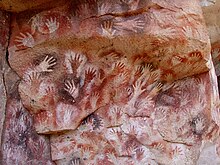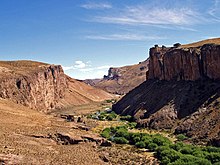Cueva de las Manos, Spanish for cave of the hands, is a natural and cultural monument in Patagonia, of southwest Argentina, in the province of Santa Cruz. It has been a UNESCO World Heritage Site since 1999 and contains the most famous cave paintings of southern South America.
Understand
editThe cave discovered by a monk in 1941 is located in the canyon of the Río Pinturas, about 80 km (50 mi) south of the small town of Perito Moreno.
The paintings date from 7000 to 1000 BC, according to other sources there are also some from up to 13000 BC. There is controversy about the dates, because if the older dates are correct, this could overturn the Clovis theory, which is widespread in the scientific community. According to it the whole of America was colonized from Alaska. Other sites from the region and southern Chile, some of which even go as far as approx. 30000 BC. BC (especially Monte Verde) would be significantly older than the oldest finds in North America, which would rather indicate a separate settlement of South America from Polynesia, for example.
History
editLandscape
editThe canyon itself is one of the most spectacular in Patagonia. The Río Pinturas cuts through multi-colored rocks and flows about 60-100 m below the Meseta. It forms a narrow, bushy green strip that contrasts with the reddish-ocher-yellow bare rocks.
Flora and fauna
editFlora is limited to simple bushes and grasses due to the drought. Guanacos, rheas, foxes, hares, armadillos, pumas (very rare and very shy) and snakes live here, though.
Climate
editOverall the area is cold-climate. The summers are mild and sunny (20–25°C during the day), the winters a bit cloudy and quite cold (around 0–5°C). Snow does occur, but is quite rare because of the drought.
Get in
edit
The best way to get there is via the small town of Perito Moreno. This is connected to the LADE flight network and the bus network (good connections to Comodoro Rivadavia, the nearest major airport). Organized tours can be booked from Perito Moreno.
A tour from El Calafate is also possible, but this means a journey of approx. 500 km (310 mi) via the graveled Ruta 40, public transport is not available.
Fees and permits
editGet around
editThe access roads to the cave are not paved. There is one from Bajo Caracoles, a tiny town 30 km west of the cave, and one directly from Perito Moreno.
Access to the cave is only permitted with a guide. There are several trails in the area that can be hiked.
See
edit
Depending on the style, the paintings are divided into three groups, which are labeled with the letters A, B, and C.
Although the Cueva de las Manos is the most important site, there are also comparable paintings in other caves and on rock faces in the gorge. The color of the paintings consists of plaster of paris and iron.
Do not go at 11:00 or 12:00 during summer, when the first paintings are exposed to the sun and barely visible.
Group A
editGroup A is the one with the highest artistic level. It mainly consists of hunting scenes in which guanacos and people are depicted, the people being painted smaller than the guanacos. The human figures are shown in several poses, which reveal a remarkable ability to represent agility. The paintings in this group are in black, yellow ocher, light red and purple.
Group B
editIn group B there are mainly static human figures with small heads, representations of guanacos, prints of hands and various abstract representations such as circles, spirals, rows of dots, serpentine lines and rectangles. The paintings are black and purple in color.
Group C
editGroup C consists of representations of hands in a negative form, i.e. the outline of the hand was represented by painting over it, as well as relatively large human figures. The hand representations of this type are only known to this day in this cave. Red tones dominate.
Do
editBuy
editThere is a visitor center, where souvenirs and sundries can be bought. Otherwise supplies are available in Perito Moreno or Bajo Caracoles.
Eat
editPerito Moreno has a few restaurants, none are in Bajo Caracoles.
Drink
editSleep
editStay safe
editGo next
editThere are numerous other caves in the area, some of which contain other paintings. Before you visit, you have to make arrangements with the local population - there are no organized tours and the access routes are not obvious. With a little luck you can find a driver to accompany you on the tour, for a fee.

